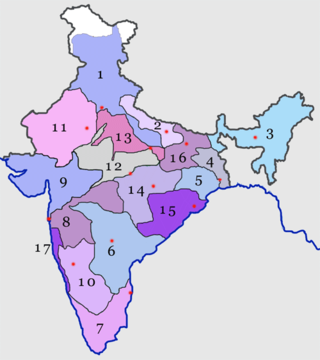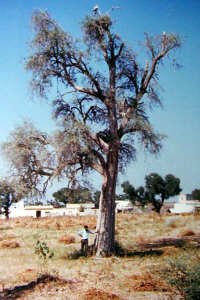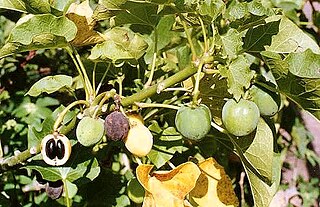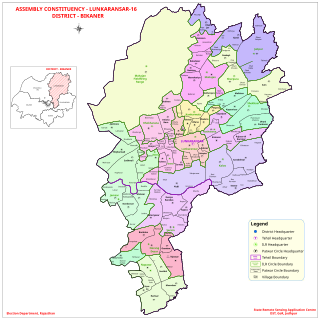Related Research Articles

Rajasthan is a state in northwestern India. It covers 342,239 square kilometres (132,139 sq mi) or 10.4 per cent of India's total geographical area. It is the largest Indian state by area and the seventh largest by population. It is on India's northwestern side, where it comprises most of the wide and inhospitable Thar Desert and shares a border with the Pakistani provinces of Punjab to the northwest and Sindh to the west, along the Sutlej-Indus River valley. It is bordered by five other Indian states: Punjab to the north; Haryana and Uttar Pradesh to the northeast; Madhya Pradesh to the southeast; and Gujarat to the southwest. Its geographical location is 23°.3' to 30°.12' North latitude and 69°.30' to 78°.17' East longitude, with the Tropic of Cancer passing through its southernmost tip.

The Thar Desert, also known as the Great Indian Desert, is an arid region in the north-western part of the Indian subcontinent that covers an area of 200,000 km2 (77,000 sq mi) in India and Pakistan. It is the world's 18th-largest desert, and the world's 9th-largest hot subtropical desert.

The North Western Railway is one of 19 railway zones in India. It is headquartered at Jaipur, Rajasthan and has 59,075+ employees, 658+ stations and a route length of more than 5,761 kilometres (3,580 mi) across the states of Rajasthan, Gujarat, Punjab and Haryana. NWR operates international rail service Thar Express from Jodhpur to Karachi. This zone is the key enabler of the Delhi–Mumbai Industrial Corridor Project by virtue of running railways 1,500 km long Western Dedicated Freight Corridor.
Churu is a city in the desert region of Rajasthan state of India. It is known as the gateway to the Thar Desert of Rajasthan. It is the administrative headquarter of Churu District. It lies in the Thar Desert on the National Highway 52 connecting Sangrur to Ankola and is a junction station on the railway line to Bikaner. It is near the shifting sand dunes of the Thar Desert and has grand havelis with marvelous fresco paintings, namely Kanhaiya Lal Bagla Ki Haweli and Surana Haweli, with hundreds of small windows. It also has some fine Chhatris. Near the town is a religious seat of the Nath sect of Sadhus where there are life-size marble statues of their deities and a place for prayers. At the center of the town is a fort built about 500 years ago.
Ratangarh is a town and Tehsil of the Churu district in Rajasthan, India. Ratangarh was previously called Kolasar. It is famous for grand havelis (mansions) with frescoes, which is an architectural specialty of the Shekhawati region. Ratangarh is also famous for its handicraft work.

Harsawa is a village located in the Sikar district of Shekhawati region, in Rajasthan state, India. Harsawa is within the Fatehpur Tehsil, 8 km south along National Highway-11 from Fatehpur town. Sand dunes of the Thar Desert can be seen from Harsawa. As of 2001, the village had a total population of 1695.

Bikaner District is a district of the state of Rajasthan in western India. The historic city of Bikaner is the district headquarters. The district is located in Bikaner Division along with the three other districts of Anupgarh, Sri Ganganagar and Hanumangarh.

Jaisalmer district is the largest district in the Indian state of Rajasthan, and the third largest district in India. Located in Marwar, the city of Jaisalmer is the administrative headquarters of the district. It is around 289 km (180 mi) from the city of Jodhpur, and around 559 km (347 mi) from Jaipur, the capital of Rajasthan. As of the 2011 population census, it is the least populous district out of all 33 districts in Rajasthan.

Churu is a district of the Indian state of Rajasthan in northern India.

The Indira Gandhi Canal is the longest canal in India. It starts at the Harike Barrage near Harike, a few kilometers downriver from the confluence of the Satluj and Beas rivers in Punjab state, and ends in irrigation facilities in the Thar Desert in the northwest of Rajasthan state. Previously known as the Rajasthan Canal, it was renamed the Indira Gandhi Canal on 2 November 1984 following the assassination of Prime Minister Indira Gandhi.

Biofuel development in India centres mainly around the cultivation and processing of Jatropha plant seeds, which are very rich in oil, ranging from 27 to 40%, and averaging 34.4%. The drivers for this are historic, functional, economic, environmental, moral and political.

Suratgarh is a City/Tehsil and a municipality in Sri Ganganagar district and is the biggest tehsil among all the 7 tehsils in Sri Ganganagar district. Suratgarh is also known as Cotton city & Bowl of grain of Rajasthan due to high production level of Cotton and wheat in this area. Suratgarh is 77 Km away in South from it district headquarters just nearby Sri Ganganagar city in Sri Ganganagar district in the Indian state of Rajasthan. Founded by Maharaja Surat Singh. Hindi, Bagri and Rajasthani are the widely spoken languages of the city.

Rajasthan is a mineral-rich state and has a diversified economy having agriculture, mining and tourism as its main engines of growth. The state mines produce gold, silver, sandstone, limestone, marble, rock phosphate, copper and lignite. It is the second-largest producer of cement and contributes one tenth of the salt produced in India.

Khajuwala is a town in the Bikaner district of Rajasthan, India. It is located near the Indo-Pakistan border and is situated around 113 kilometres (70 mi) from the district headquarters Bikaner. It is an intermediate panchayat with several villages under its administration. It produces a lot of raw cotton and wheat. Indira Gandhi Canal has brought about development of this area. It is a big agro products market in Bikaner district. Earlier its name was Beriyawali. It is also seat in Rajasthan legislative assembly. The current elected Member of Legislative assembly (MLA) from Khajuwala is Govind ram meghwal (INC). Khajuwala has recently been given a status of Panchayat samiti.

Lunkaransar is a town, near city of Bikaner in the Bikaner district of Indian state of Rajasthan. Lunkaransar lake in Rajasthan is a playa lake formed due to deflation. Lunkaransar is most popular for Peanuts in Rajasthan.

Maru Pradesh is a geographical, cultural, social, economic, political, linguistic region of the Thar Desert, in the Northwest, India. It is also a proposed state in India with its proposed capital being Jodhpur, the largest city of Maru Pradesh. It would be carved out from the state of Rajasthan. The proposed state would consist the districts of Jalore, Balotra, Barmer, Sanchore, Sirohi, Didwana Kuchaman, Hanumangarh, Jaisalmer, Bikaner, Jhunjhunu, Jodhpur, Jodhpur Rural, Nagaur, Pali, Phalodi, Anupgarh, Sikar, Neem ka Thana, Churu, Sri Ganganagar, Beawar.
Sri Gurusar Modia is a village in the Indian state of Rajasthan situated near borders of Rajasthan, Haryana and Punjab states and the international border of India and Pakistan. This village is located in the tehsil Suratgarh of district Sriganganagar. Suratgarh, once known as Sodhal was believed to be surrounded by the confluence of Saraswati and Drishyati rivers but now the land is a deserted one lying amidst the expanse of The great Indian Thar desert. Suratgarh is famous for its agriculture, air force and army base stations, largest thermal power plant of Rajasthan and largest radio station of Rajasthan called as "Cotton City Channel". Sri Gurusar Modia came into limelight when a controversial self-proclaimed saint and spiritual leader Gurmeet Ram Rahim Singh was believed to be incarnated there and crowned to the throne of Dera Sacha Sauda at Sirsa in 1991. With setting up of Shah Satnam Schools for both boys and girls, super speciality hospitals etc. this village became nationwide popular

The climate of Rajasthan in northwestern India is generally arid or semi-arid and features fairly hot temperatures over the year with extreme temperatures in both summer and winter. The hottest months are May and June. The monsoon season is from July to September; however, rainfall remains moderate.
Shyam Sunder Jyani is an Indian environmentalist and academic, best known for afforestation efforts in the Indian state of Rajasthan. He is presently an associate professor of sociology at Dungar College, Bikaner.

Malasar(हिंदी: मालासर) is a large village located in Bikaner District which is in the north-west of the state of Rajasthan, India. This village is the Panchayat headquarters of three nearby villages. There are a total of 450 houses in the village. This village is popular for its unique geographical location, beautiful sand dunes and sandy paths located in the heart of the Thar Desert.
References
- ↑ "India Olive Oil Market Outlook (2020-2025) - Drivers and Challenges - ResearchAndMarkets.com". www.businesswire.com. 2020-02-19. Retrieved 2021-11-28.
- 1 2 3 4 5 Sood, Jyotika. "Rajasthan's olive dream". www.downtoearth.org.in. Retrieved 2021-11-28.
- ↑ "Home". Rajasthan Olive Cultivation Limited. Retrieved 2021-11-28.
- ↑ "Greening India's deserts with olives | Nishika Patel". the Guardian. 2011-04-04. Retrieved 2021-11-28.
- ↑ "Indian exotica". The Financial Express. 2015-07-19. Retrieved 2021-11-28.
- ↑ "Olive has begun thriving in Rajasthan". Business Today. Retrieved 2021-11-28.
- ↑ "Olive Cultivation an Innovative Project" (PDF). Rashtriya Krishi Vikas Yojana. Retrieved 28 November 2021.
- 1 2 IANS (2016-10-28). "Rajasthan promotes progressive farming with olive cultivation (Lead, with Images)". Business Standard India. Retrieved 2021-11-28.
- ↑ "India's plan to become a leading olive oil producer". BBC News. 2013-07-16. Retrieved 2021-11-28.
- ↑ "Rajasthan produces 100 Tonnes of olives, production expected to grow manyfold". DNA India. Retrieved 2021-11-28.
- ↑ "How the Italian olive is blooming in Rajasthan desert - Times of India". The Times of India. Retrieved 2021-11-28.
- ↑ "Rajasthan to scale up olive cultivation area to 5,200 hectares". The Economic Times. Retrieved 2021-11-28.
- ↑ "India Set to Launch its Own Olive Oil Brand". Olive Oil Times. 2016-11-01. Retrieved 2021-11-28.
- ↑ "Rajasthan to launch country's first indigenous olive oil brand". The Economic Times. Retrieved 2021-11-28.
- ↑ Tripathy, Srikanta. "Rajasthan: Olive oil crushing starts, farmers expect record harvest". The Times of India. Retrieved 2021-11-28.